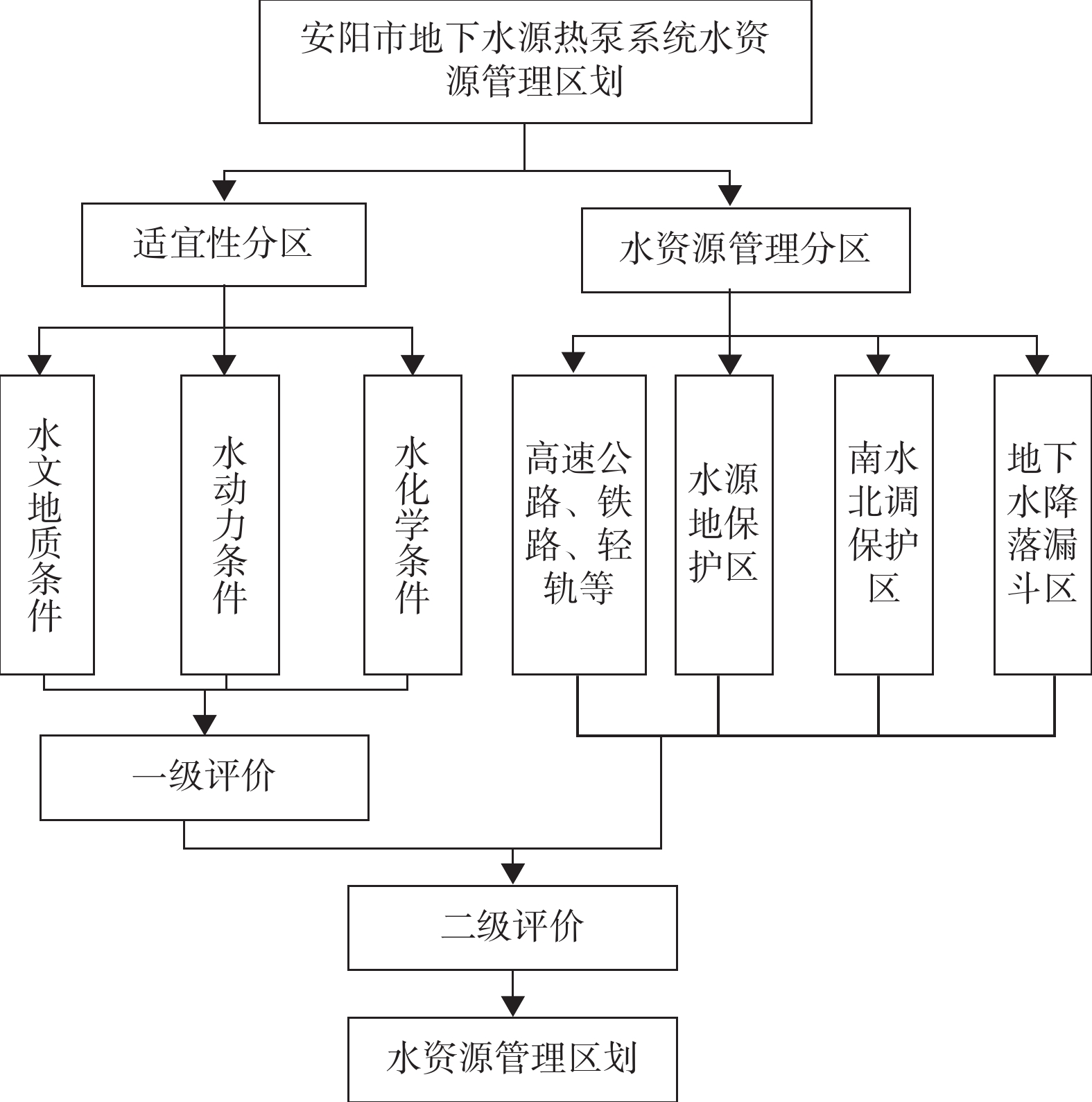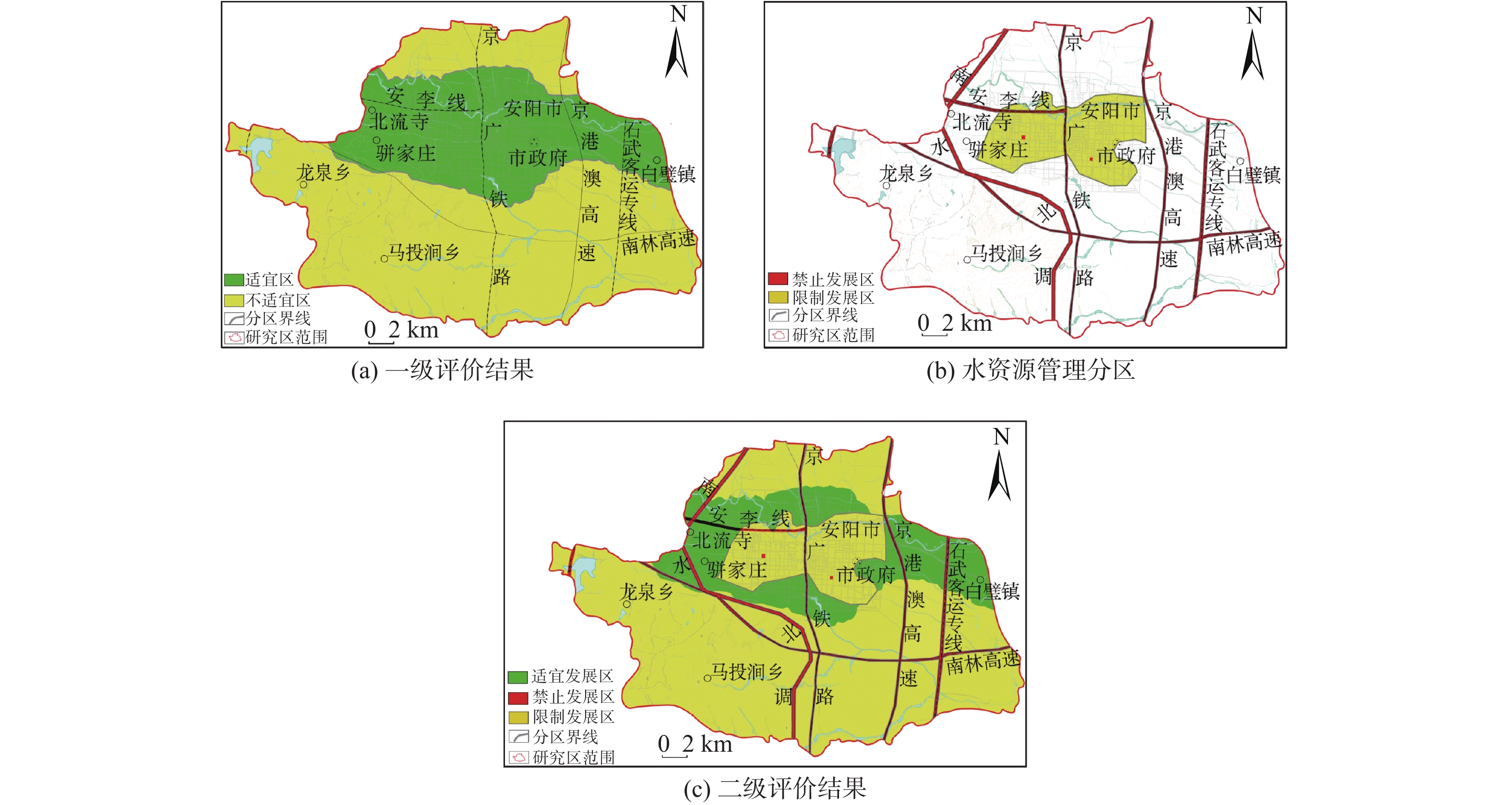A study of the water resources management and division of the groundwater heat pump system construction in Anyang
-
摘要:
为从赋存条件和水资源管理两个层面进行地下水源热泵系统建设的区划研究,实施技术与管理的结合,通过分析水文地质条件、水动力条件和水化学条件,结合水资源管理分区,建立了安阳市地下水源热泵系统水资源管理区划评价体系。采用云模型改进的层次分析法进行了一级评价,在此基础上结合水资源管理分区利用GIS空间分析功能完成二级评价,将研究区地下水源热泵系统划分了3个等级。结果表明:研究区范围内地下水源热泵系统适宜发展区面积为117.45 km2,主要分布在安阳河冲洪积扇扇体中心强富水区,部分分布在扇缘的外围区域;限制发展区面积为459.26 km2,分布在扇缘的西南和北部丘陵弱富水区以及扇体中心的地下水降落漏斗区;禁止发展区面积为24.02 km2,分布在水源地和南水北调保护区以及铁路和高速公路两旁,在研究区交错分布。在适宜性分区的基础上结合水资源管理的区划研究更全面合理,可为地下水源热泵系统科学布局及合理的开发利用提供参考。
Abstract:Considering the occurrence condition and water resources management, this paper studies the zoning of the groundwater heat pump system in the city of Anyang in Henan, makes the combination of technology and management and improves the evaluation standard, which is of more practicability. The evaluation of groundwater resources management and division is established by synthetically analyzing the hydrogeological, hydrodynamic and hydrochemical conditions of Anyang. The first-level evaluation is carried out by using the improved analytic hierarchy process of cloud model. The second-level evaluation is completed by using GIS spatial analysis function, dividing the groundwater heat pump system into three grades in the study area. The results show that the suitable development area for the groundwater heat pump system is 117.45 km2, which mainly distributes in the strong groundwater-abundant area in the center of the alluvial-proluvial fan of the Anyang River and partially distributes in the peripheral area at the fan edge. The restricted development area covers an area of 459.26 km2, which distributes in the hilly weak groundwater-abundant areas in southwest and north of the fan margin with the groundwater level drawdown funnel in the center of the fan body. The forbidden development area is of 24.02 km2 and distributes crossly, covering the water source area, the protected area of the South-to-North Water Transfer Project, along the railway and expressway. It is more comprehensive and reasonable to take the groundwater resources management and division into account on the basis of the suitability zoning, which may provide references for the scientific layout and rational development and utilization of the groundwater heat pump system.
-
Key words:
- groundwater heat pump /
- cloud model /
- water resources management and division /
- Anyang
-

-
表 1 研究区适宜性分区指标基本特征
Table 1. Basic characteristics of the suitability zoning index of the study area
水文地质条件 编号 富水性/( m3·d−1) 单井回灌率/% 含水层厚度
/m编号 富水性/(m3·d−1) 单井回灌率/% 含水层厚度/m Z1 518 54.44 19 Z4 5112 75.11 36 Z2 677 44.65 17 Z5 756 65.71 42 Z3 5232 91.74 38 Z6 1735 65.56 45 水化学条件 编号 水化学类型 硬度
/( mg·L−1)溶解性总固体
/(mg·L−1)编号 水化学类型 硬度
/( mg·L−1)溶解性总固体
/(mg·L−1)X1 HCO3—Mg·Ca 583.5 1070 X13 HCO3·Cl—Ca 620.5 1120 X2 HCO3·Cl—Ca 555.5 870 X14 HCO3—Ca 540.0 900 X3 HCO3—Ca 441.0 760 X15 HCO3·SO4—Ca 548.5 910 X4 SO4—Na 200.0 1150 X16 HCO3—Ca 447.5 740 X5 HCO3—Ca 696.5 1160 X17 HCO3—Ca 392.0 640 X6 HCO3—Ca 286.5 480 X18 HCO3·SO4—Ca 499.5 780 X7 HCO3—Ca 549.0 930 X19 SO4·HCO3—Ca 419.5 700 X8 Cl·SO4—Ca 1175.5 1800 X20 HCO3—Ca 348.5 590 X9 HCO3·Cl—Ca 768.0 1380 X21 HCO3·Cl—Ca 691.5 1190 X10 HCO3—Ca·Mg 318.5 550 X22 HCO3·SO4—Ca 596.5 1010 X11 HCO3—Ca 340.5 580 X23 HCO3·SO4—Ca 548.5 910 X12 SO4·Cl—Ca 604.5 1230 水动力条件 编号 地下水位
埋深/m地下水位
年变幅/m编号 地下水位
埋深/m地下水位
年变幅/m编号 地下水位
埋深/m地下水位
年变幅/m编号 地下水位
埋深/m地下水位
年变幅/mY1 25.75 −0.13 Y9 10.02 0.97 Y17 4.68 −0.07 Y25 61.00 3.28 Y2 14.60 −1.30 Y10 12.30 0.50 Y18 3.00 0.18 Y26 20.10 1.60 Y3 13.26 −0.31 Y11 5.37 0.49 Y19 10.96 1.16 Y27 15.25 0.47 Y4 19.24 −1.02 Y12 3.40 −0.43 Y20 26.28 0.92 Y28 17.48 1.03 Y5 24.05 −3.69 Y13 6.23 1.45 Y21 30.64 −0.19 Y29 14.19 −0.37 Y6 25.80 −0.30 Y14 3.31 −0.74 Y22 30.70 0.50 Y30 12.72 −0.28 Y7 13.23 2.23 Y15 4.14 0.09 Y23 44.32 1.22 Y31 12.20 −0.90 Y8 10.12 0.05 Y16 4.76 −1.19 Y24 36.98 −2.97 Y32 9.09 0.87 表 2 云模型重要性标度定义
Table 2. Definition of the importance scale of cloud model
标度 含义 C1(1,0.707,0.118),Ex1=1 两因素相比,要素i和j具有
同等重要性C3(3,0.707,0.118),Ex3=3 两因素相比,要素i和j具有
稍微重要性C5(5,0.707,0.118),Ex5=5 两因素相比,要素i和j具有
明显重要性C7(7,0.707,0.118),Ex7=7 两因素相比,要素i和j具有
强烈重要性C9(9,0.707,0.118),Ex9=9 两因素相比,要素i和j具有
极端重要性C2(2,0.437,0.073),Ex2=2 上述相邻重要性的中值 C4(4,0.437,0.073),Ex4=4 C6(6,0.437,0.073),Ex6=6 C8(8,0.437,0.073),Ex8=8 表 3 云模型改进层次分析法的权重计算结果
Table 3. Weight calculation results of the cloud model improved AHP
属性层 权重计算 要素层 权重计算 合成权重 传统的权重计算 Ex En He Ex En He Ex En He 专家1 专家2 水文地质条件 0.627 0.611 0.613 富水性 0.563 0.556 0.560 0.353 0.340 0.343 0.207 0.349 回灌率 0.306 0.315 0.314 0.192 0.192 0.192 0.361 0.124 含水层厚度 0.131 0.129 0.126 0.082 0.079 0.077 0.080 0.066 水动力条件 0.238 0.246 0.245 地下水位埋深 0.688 0.688 0.874 0.164 0.169 0.214 0.153 0.260 地下水位年变幅 0.313 0.313 0.126 0.074 0.077 0.031 0.077 0.130 水化学条件 0.135 0.143 0.142 水化学类型 0.546 0.544 0.547 0.074 0.078 0.078 0.066 0.038 硬度 0.288 0.285 0.287 0.039 0.041 0.041 0.036 0.012 溶解性总固体 0.166 0.171 0.166 0.022 0.024 0.024 0.020 0.021 表 4 指标赋分分级
Table 4. Index scoring
项目 分级 赋值 富水性/(m3·d−1) (0,500) 1 [500,1000] 3 (1000,3000] 6 (3000,6000) 9 回灌率/% (0,50) 4 [50,75] 6 (75,100) 9 含水层厚度/m (0,10) 3 [10,30] 5 (30,50) 8 地下水位埋深/m (0,5) 1 [5,10] 5 (10,15] 7 (15,100) 9 地下水位年变幅/m (−5,−1.5) 3 [−1.5,−0.8] 6 (−0.8,5) 8 水化学类型 HCO3—Ca 8 HCO3·Cl—Ca 6 HCO3·SO4—Ca 5 Cl·SO4—Ca 3 硬度/(mg·L−1) (0,200) 7 [200,450] 4 (450,1500) 2 溶解性总固体/(mg·L−1) (0,500) 9 [500,1000] 7 (1000, 2 000) 4 -
[1] 孔维臻, 郭明晶, 陈萌, 等. 基于模糊AHP的浅层地热能适宜性分区评价方法研究[J]. 中国矿业,2013,22(2):107 − 110. [KONG Weizhen, GUO Mingjing, CHEN Meng, et al. Study on evaluation method of regionalization of shallow geothermal energy based on fuzzy AHP[J]. China Mining Magazine,2013,22(2):107 − 110. (in Chinese with English abstract) doi: 10.3969/j.issn.1004-4051.2013.02.027
[2] 倪龙, 封家平, 马最良. 地下水源热泵的研究现状与进展[J]. 建筑热能通风空调,2004,23(2):26 − 31. [NI Long, FENG Jiaping, MA Zuiliang. The state of research and development of groundwater heat pump systems[J]. Building Energy & Environment,2004,23(2):26 − 31. (in Chinese with English abstract) doi: 10.3969/j.issn.1003-0344.2004.02.006
[3] RUSSO S L, TADDIA G, BACCINO G, et al. Different design scenarios related to an open loop groundwater heat pump in a large building: Impact on subsurface and primary energy consumption[J]. Energy and Buildings,2011,43(2/3):347 − 357.
[4] 刘立才, 王金生, 张霓, 等. 北京城市规划区水源热泵系统应用适宜性分区[J]. 水文地质工程地质,2006,33(6):15 − 17. [LIU Licai, WANG Jinsheng, ZHANG Ni, et al. Suitability division for water source heat pumps in the central districts of Beijing[J]. Hydrogeology & Engineering Geology,2006,33(6):15 − 17. (in Chinese with English abstract) doi: 10.3969/j.issn.1000-3665.2006.06.004
[5] 金婧, 席文娟, 陈宇飞, 等. 基于AHP的浅层地热能适宜性分区评价[J]. 水资源与水工程学报,2012,23(3):91 − 93. [JIN Jing, XI Wenjuan, CHEN Yufei, et al. Assessment of suitability of shallow geothermal energy based on AHP[J]. Journal of Water Resources and Water Engineering,2012,23(3):91 − 93. (in Chinese with English abstract)
[6] 马聪, 周维博, 李娜. 西安市主城区地下水源热泵适宜性分区[J]. 南水北调与水利科技,2014,12(3):156 − 159. [MA Cong, ZHOU Weibo, LI Na. Suitability zonation for groundwater source heat pumps in Xi’an[J]. South-to-North Water Transfers and Water Science & Technology,2014,12(3):156 − 159. (in Chinese with English abstract)
[7] 陈文芳, 杜尚海, 张一博, 等. 水源热泵运行中多组份溶质的反应迁移模拟[J]. 工程勘察,2017,45(7):32 − 38. [CHEN Wenfang, DU Shanghai, ZHANG Yibo, et al. Reactive transport simulation of multi-component solute in the operation of water source heat pump system[J]. Geotechnical Investigation & Surveying,2017,45(7):32 − 38. (in Chinese with English abstract)
[8] 冯连威, 王林, 马爱华, 等. 梯级利用地下水储能的地源热泵空调系统分析[J]. 河南科技大学学报(自然科学版),2020,41(3):20 − 26. [FENG Lianwei, WANG Lin, MA Aihua, et al. Exergy analysis of ground source heat pump air-conditioning system with cascade utilization of ground water energy storage[J]. Journal of Henan University of Science and Technology (Natural Science),2020,41(3):20 − 26. (in Chinese with English abstract)
[9] 闫峭. 地下水源热泵抽灌井群理论及应用研究——以西安市为例[D]. 西安: 长安大学, 2017
YAN Qiao. Study on the theory and application of the ground-water heat pump wells: Taking Xi’an city as an example [D]. Xi’an: Chang’an University, 2017. ( in Chinese with English abstract )
[10] 李颖智, 蔡五田, 耿婷婷, 等. 区域地下水污染调查取样点布设量化分配方法[J]. 水文地质工程地质,2019,46(5):24 − 30. [LI Yingzhi, CAI Wutian, GENG Tingting, et al. Quantitative sample distribution in regional groundwater contamination investigation[J]. Hydrogeology & Engineering Geology,2019,46(5):24 − 30. (in Chinese with English abstract)
[11] AKAA O U, ABU A, SPEARPOINT M, et al. A group-AHP decision analysis for the selection of applied fire protection to steel structures[J]. Fire Safety Journal,2016,86:95 − 105. doi: 10.1016/j.firesaf.2016.10.005
[12] ZHOU X Y, HU Y, DENG Y, et al. A DEMATEL-based completion method for incomplete pairwise comparison matrix in AHP[J]. Annals of Operations Research,2018,271(2):1045 − 1066. doi: 10.1007/s10479-018-2769-3
[13] 苑雷, 陈刚. 改进层次分析法下的浅层地温能适宜性评价[J]. 可再生能源,2013,31(7):112 − 115. [YUAN Lei, CHEN Gang. Assessment of suitability of shallow geothermal energy based on improved analytic hierarchy process[J]. Renewable Energy Resources,2013,31(7):112 − 115. (in Chinese with English abstract)
[14] 张向营, 张春山, 孟华君, 等. 基于Random Forest和AHP的贵德县北部山区滑坡危险性评价[J]. 水文地质工程地质,2018,45(4):142 − 149. [ZHANG Xiangying, ZHANG Chunshan, MENG Huajun, et al. Landslide hazard evaluation in the northern mountainous area of Guide County based on Random Forest and AHP[J]. Hydrogeology & Engineering Geology,2018,45(4):142 − 149. (in Chinese with English abstract)
[15] 夏亮, 王永攀, 杨江平, 等. 一种基于云模型标度的改进层次分析法[J]. 空军预警学院学报,2019,33(2):112 − 115. [XIA Liang, WANG Yongpan, YANG Jiangping, et al. A modified analytical hierarchy process based on scale of cloud model[J]. Journal of Air Force Early Warning Academy,2019,33(2):112 − 115. (in Chinese with English abstract) doi: 10.3969/j.issn.2095-5839.2019.02.008
[16] PENG Y X, WU L, ZUO Q J, et al. Risk assessment of water inrush in tunnel through water-rich fault based on AHP-Cloud model[J]. Geomatics, Natural Hazards and Risk,2020,11(1):301 − 317. doi: 10.1080/19475705.2020.1722760
[17] 张彪, 戴兴国. 基于有限区间云模型和距离判别赋权的岩体质量分类模型[J]. 水文地质工程地质, 2017, 44(5): 150-157.
ZHANG Biao, DAI Xingguo A classification model of rock mass based on finite interval cloud model and distance discrimination weighting[J]. Hydrogeology & Engineering Geology, 2017, 44(5): 150 − 157. ( in Chinese with English abstract )
[18] 王洪利, 冯玉强. 基于云模型标度判断矩阵的改进层次分析法[J]. 中国管理科学,2005,13(增刊1):32 − 37. [WANG Hongli, FENG Yuqiang. Improved AHP based on judgment matrix scaled with cloud model[J]. Chinese Journal of Management Science,2005,13(Sup1):32 − 37. (in Chinese with English abstract)
[19] 江迎. 基于云模型和GIS/RS的坝堤溃决风险分析及灾害损失评估研究[D]. 武汉: 华中科技大学, 2012.
JIANG Ying. Study on risk analysis and disaster loss assessment of dam break based on cloud model and GIS/RS[D]. Wuhan: Huazhong University of Science and Technology, 2012. ( in Chinese with English abstract )
[20] LI N. Basketball culture event detection based on comprehensive integrated method[J]. Personal and Ubiquitous Computing,2020,24(47):193 − 206. doi: 10.1007/s00779-019-01254-9
[21] 潘俊, 张宗禹, 关昊鹏, 等. 地下水源热泵热源井布设合理性评价指标体系[J]. 沈阳建筑大学学报(自然科学版),2016,32(3):560 − 568. [PAN Jun, ZHANG Zongyu, GUAN Haopeng, et al. Rationality evaluation index system on the design of heat source well for groundwater source heat pump[J]. Journal of Shenyang Jianzhu University (Natural Science),2016,32(3):560 − 568. (in Chinese with English abstract)
[22] 梁乃森, 钱程, 穆文平, 等. 大牛地气田区地下水水质模糊综合评价[J]. 水文地质工程地质,2020,47(3):52 − 59. [LIANG Naisen, QIAN Cheng, MU Wenping, et al. Fuzzy comprehensive evaluation of groundwater quality of the Daniudi gas field area[J]. Hydrogeology & Engineering Geology,2020,47(3):52 − 59. (in Chinese with English abstract)
[23] 赖光东, 周维博, 姚炳光. 西安地区浅层承压水水源热泵适宜性评价[J]. 长江科学院院报,2017,34(12):22 − 27. [LAI Guangdong, ZHOU Weibo, YAO Bingguang. Suitability evaluation for shallow confined water source heat pump in Xi’an[J]. Journal of Yangtze River Scientific Research Institute,2017,34(12):22 − 27. (in Chinese with English abstract) doi: 10.11988/ckyyb.20161274
[24] 刘九龙, 林黎, 程万庆. 天津市地下水源热泵系统适宜性分区[J]. 吉林大学学报(地球科学版),2012,42(增刊1):380 − 385. [LIU Jiulong, LIN Li, CHENG Wanqing. Suitability zoning for groundwater source heat pump systems in Tianjin[J]. Journal of Jilin University (Earth Science Edition),2012,42(Sup1):380 − 385. (in Chinese with English abstract)
[25] 闫佰忠,孙剑,王昕洲,等. 基于GIS-FAHP的石家庄市地下水源热泵适宜性分区[J]. 吉林大学学报(地球科学版),2021,51(4):1172 − 1181. [YAN Baizhong, SUN Jian, WANG Xinzhou,et al. Suitability zoning of groundwater source heat pump in Shijiazhuang based on GIS-FAHP[J]. Journal of Jilin University (Earth Science Edition),2021,51(4):1172 − 1181. (in Chinese with English abstract)
[26] 赵静. 水源热泵对地温场的影响及适宜性评价研究——以郑州市为例[D]. 北京: 中国地质大学(北京), 2009.
ZHAO Jing. Impact of GWSHP on groundwater temperature field and suitability assessment: A case study in Zhengzhou city[D]. Beijing: China University of Geosciences(Beijing), 2009. ( in Chinese with English abstract )
[27] 胡元平, 刘红卫, 柯立, 等. 武汉市都市发展区地下水源热泵适宜性评价[J]. 资源环境与工程,2014,28(6):981 − 984. [HU Yuanping,LIU Hongwei,KE Li, et al. The suitability evaluation of groundwater heat pump in the urban development area of Wuhan[J]. Resources Environment & Engineering,2014,28(6):981 − 984. (in Chinese with English abstract) doi: 10.3969/j.issn.1671-1211.2014.06.051
-




 下载:
下载:

